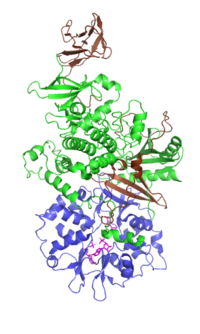
Photo from wikipedia
This study examined the effects on conformation and oxidation of myofibrillar protein in largemouth bass by different thawing methods. The conventional thawing, microwave thawing, microwave (MVT) or ultrasound combined with… Click to show full abstract
This study examined the effects on conformation and oxidation of myofibrillar protein in largemouth bass by different thawing methods. The conventional thawing, microwave thawing, microwave (MVT) or ultrasound combined with vacuum thawing, microwave or far-infrared thawing (FMT) combined with magnetic nanoparticles were used in this experiment. The physicochemical changes were analyzed by differential scanning calorimetry and dynamic rheology. The protein structure changes were measured by Raman, intrinsic fluorescence, and second-derivative ultraviolet spectrometry. The degree of protein aggregation was evaluated by surface hydrophobicity, particle size, and zeta-potential measurements. Total sulfhydryl content, protein carbonyl content, Ca2+ -ATPase activity, and SDS-PAGE were used to analyze the degree of protein oxidation. Results showed that MVT and FMT samples had better thermal stability, more stable protein conformation, and a lower degree of protein oxidation. Thus, these two methods would be beneficial to sustain the quality of thawed fillets. PRACTICAL APPLICATIONS: In the market circulation, largemouth bass (Micropterus salmoides) need to be frozen. The thawing methods can directly affect the quality of frozen fish, thus causing the changes in the conformation of the myofibrillar protein in fish, and also affecting the degree of protein oxidation. The results showed that the microwave combined with vacuum and the magnetic nanoparticles combined with far-infrared thawing had less effect on myofibrillar protein of fish and were a better thawing method.
Journal Title: Journal of food science
Year Published: 2020
Link to full text (if available)
Share on Social Media: Sign Up to like & get
recommendations!